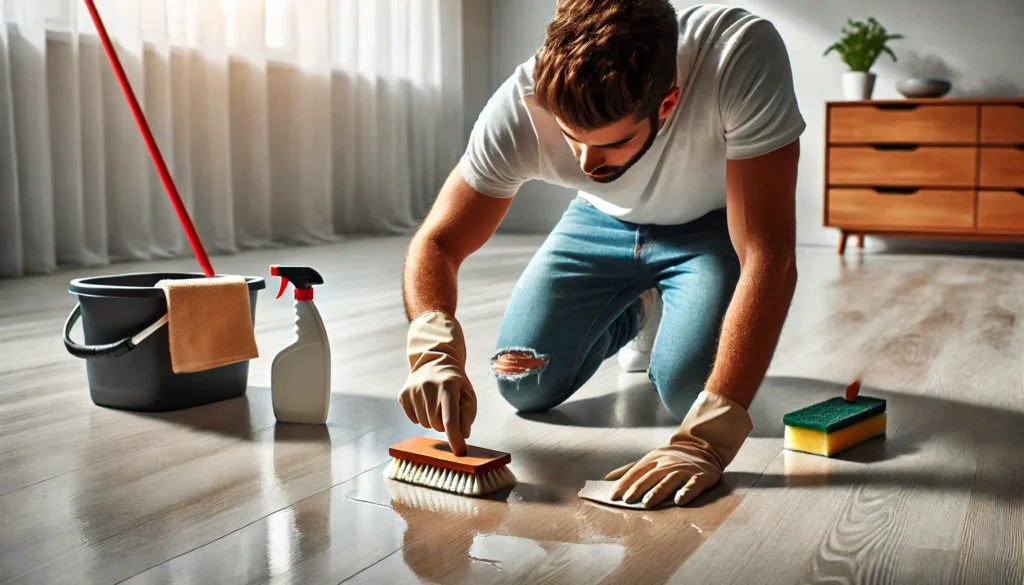
Vinyl flooring is a popular choice in many homes for its durability, water resistance, and aesthetic appeal. But as resilient as vinyl can be, it’s not immune to stains from spills, dirt buildup, or scuffs. Many homeowners face the challenge of removing these stains without damaging the surface. If you’ve ever looked down at your vinyl floor in frustration, wondering if those stubborn stains will ever come out, you’re not alone.
This guide will walk you through effective and safe methods to remove stains from vinyl flooring, so you can restore its beauty and keep it looking like new. You’ll learn how to tackle specific types of stains, what cleaning agents are safe to use, and practical tips to make this process easy and efficient.
Step-by-Step Instructions for Removing Stains from Vinyl Flooring
Step 1: Gather Essential Cleaning Supplies
For successful stain removal, having the right tools on hand is key. Here’s a basic list of what you’ll need for most stains on vinyl:
- Mild dish soap or white vinegar: Great for general cleaning.
- Baking soda: Acts as a mild abrasive.
- Soft-bristle brush or cloth: Essential for scrubbing without scratching.
- Isopropyl alcohol: Useful for ink and makeup stains.
- Oxalic acid-based cleaner: Ideal for tough stains like rust.
- Clean, dry towels: For drying and buffing.
Having these items on hand helps you respond quickly to stains as they happen, making removal easier and reducing the chances of permanent discoloration.
Why It Matters: Using the right tools ensures that you avoid damage while effectively removing stains. For example, a harsh cleaner could degrade vinyl’s protective layer, leading to dullness and susceptibility to future stains.
Step 2: Identify the Type of Stain
Vinyl floors can encounter a wide range of stains, from common spills to tough grime. Here’s a quick guide to help you determine the type of stain you’re dealing with:
- Food and drink spills: Coffee, tea, and juice stains are typically surface-level and can be removed with basic cleaning.
- Ink and makeup stains: These may penetrate deeper, requiring a solvent like isopropyl alcohol.
- Rust stains: Often from metal furniture legs or items left on the floor for extended periods.
- Scuff marks: Caused by rubber-soled shoes or furniture, these marks are more superficial but may need gentle abrasion to remove.
Pro Tip: Before diving in with any cleaning product, test a small, hidden section of the floor to ensure it won’t damage the vinyl. This way, you can avoid unexpected discoloration or warping.
Step 3: Pre-Treat the Stain with a Gentle Cleaner
Start with the mildest cleaning solution to see if it removes the stain. For general food and drink stains, follow these steps:
- Mix one part mild dish soap with four parts warm water.
- Apply the solution to the stain using a cloth, allowing it to sit for five minutes.
- Scrub gently with a soft-bristle brush, then rinse the area with clean water.
- Dry with a soft towel to prevent any watermarks.
For light stains, this should be enough to lift them off the vinyl surface.
Why It Matters: Pre-treating with a gentle solution reduces the need for harsh chemicals that could damage your flooring. This step also helps you gauge the stain’s resistance without compromising the vinyl’s integrity.
Step 4: Use Baking Soda for Tougher Stains
If the mild cleaner didn’t work, try using baking soda, which provides gentle abrasiveness without scratching vinyl surfaces:
- Sprinkle baking soda directly onto the stain.
- Dampen a cloth with warm water and scrub the baking soda into the stain with circular motions.
- Rinse with water and wipe dry.
Baking soda is especially useful for greasy stains or food spills that have hardened.
Pro Tip: Avoid using steel wool or other abrasive scrubbers, as they can leave permanent scratches on vinyl.
Step 5: Apply Isopropyl Alcohol for Ink and Makeup Stains
Ink, dye, and makeup stains can be tricky as they often seep deeper into vinyl. Here’s how to tackle these stains effectively:
- Pour a small amount of isopropyl alcohol onto a clean cloth.
- Blot the stain gently (avoid rubbing) to lift the ink or makeup.
- Repeat as necessary until the stain fades.
Alcohol helps dissolve the ink without leaving behind residue, making it one of the best solutions for these types of marks.
Why It Matters: Ink and makeup stains can be persistent, and alcohol’s solvent properties allow it to break down these pigments effectively. Blotting also prevents further spreading of the stain.
Step 6: Address Rust Stains with Oxalic Acid Cleaner
Rust stains often look more daunting than they actually are. Using an oxalic acid-based cleaner is typically safe and effective for vinyl floors:
- Apply the cleaner directly to the rust stain (follow the product’s instructions carefully).
- Let it sit for the recommended time (usually a few minutes).
- Rinse thoroughly with clean water and dry with a towel.
Oxalic acid works by chemically dissolving rust, lifting it from the vinyl without requiring intense scrubbing.
Pro Tip: Always wear gloves and ensure proper ventilation when working with chemical cleaners to protect your skin and respiratory system.
Step 7: Buff Out Scuff Marks
Rubber scuffs are common on vinyl, especially near doorways or in kitchens. Here’s an easy fix:
- Apply a few drops of mineral oil or baby oil to the scuff mark.
- Rub gently with a soft cloth in circular motions.
- Wipe clean with a damp cloth to remove any oily residue.
If the scuff persists, try using a clean pencil eraser as an alternative.
Why It Matters: Mineral oil is safe for vinyl and provides enough lubrication to lift scuffs without damaging the surface.
Read more: How to Clean Vinyl Plank Flooring
Troubleshooting & Additional Tips for Vinyl Floor Stain Removal
Common Issues & Fixes
- Stain Reappears After Cleaning: This often happens if the cleaner wasn’t rinsed thoroughly. Try using a damp cloth to remove any leftover residue.
- Streaks After Drying: If your vinyl appears streaky after cleaning, buff the area with a dry cloth and a bit of mineral oil.
- Lingering Odors: For stains that leave odors (like pet urine), use a mix of white vinegar and water to neutralize smells naturally.
Best Practices & Tips
- Clean Spills Immediately: Vinyl is resistant to most substances, but prolonged exposure to spills can cause staining.
- Use Rugs or Mats: Placing rugs at entry points or high-traffic areas reduces dirt and debris on the floor.
- Avoid Excessive Water: Too much water can seep into vinyl seams, leading to swelling or lifting.
Pro Tip: For vinyl flooring in kitchens, regularly wiping down areas prone to grease splatters prevents buildup and makes deep cleaning easier.
Read more: How to Clean Vinyl Floors: A Complete Guide for Pristine, Long-Lasting Flooring
FAQs about How to Get Stains Out of Vinyl Flooring
1. How often should I clean vinyl flooring to prevent stains?
Regular weekly cleaning with mild soap and water is generally enough to keep vinyl floors looking good. For high-traffic areas, consider spot cleaning daily.
2. Can I use bleach on vinyl flooring?
While bleach can effectively remove mold and mildew, it’s too harsh for most vinyl flooring. Opt for gentler solutions like vinegar instead.
3. What’s the best way to prevent stains on vinyl flooring?
Placing mats at entryways, cleaning spills immediately, and avoiding harsh chemicals are the best preventive measures.
4. Are steam mops safe for vinyl floors?
Steam mops are not recommended for vinyl as the heat and moisture can cause the floor to warp or peel over time.
5. Can I use vinegar on vinyl floors every day?
Vinegar is a good cleaner but should be used sparingly. Dilute it well with water to avoid damaging the vinyl’s finish over time.
6. What’s the ideal way to clean vinyl after a party with heavy foot traffic?
Sweep first to remove debris, then mop with a diluted vinegar solution to lift any sticky residues. Finish with a dry towel buff for a polished look.
Conclusion
Removing stains from vinyl flooring doesn’t have to be a daunting task. By following the steps outlined above and using the right cleaning agents, you can tackle virtually any stain effectively without risking damage to your floor. Regular maintenance and quick responses to spills go a long way in keeping your vinyl looking pristine and new.
With these tips in hand, say goodbye to stubborn stains and enjoy the lasting beauty of your vinyl flooring. Whether it’s a pesky ink stain or a food spill, you now have a reliable plan to restore your floors to their original glory!
